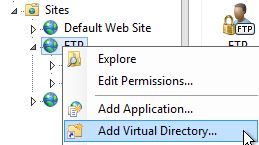

- GO FTP TRY CHANGING TO PASSIVE MODE HOW TO
- GO FTP TRY CHANGING TO PASSIVE MODE WINDOWS 7
- GO FTP TRY CHANGING TO PASSIVE MODE PROFESSIONAL
The FTP client tries to establish a passive-mode FTP connection to an IPv4 FTP server by using a dual-mode IPV6 socket. Netsh advfirewall set global StatefulFtp enableNote The filter dynamically opens ports for data connections. You run the following command to enable the firewall application filter for the FTP client:
GO FTP TRY CHANGING TO PASSIVE MODE WINDOWS 7
You run a Java-based or native C-based FTP client on a computer that is running Windows 7 or Windows Server 2008 R2.
GO FTP TRY CHANGING TO PASSIVE MODE PROFESSIONAL
These instructions are for people who's servers are listening on public IP addresses, but they have a border firewall protecting them from attacks.Windows Server 2008 R2 Enterprise Windows Server 2008 R2 Datacenter Windows Server 2008 R2 for Itanium-Based Systems Windows Server 2008 R2 Foundation Windows Server 2008 R2 Standard Windows Server 2008 R2 Web Edition Windows 7 Enterprise Windows 7 Home Basic Windows 7 Home Premium Windows 7 Professional Windows 7 Starter Windows 7 Ultimate More. The solution is really simple - Make your server co-operate with the NAT and/or Firewall.
GO FTP TRY CHANGING TO PASSIVE MODE HOW TO
I don't know how to reach 10.110.141.15Ĭlient: Connection failed. Consider this scenario where you have a client and server both behind translated addresses:Ĭlient: Please Connect to me at 10.110.141.15 The problem lies when the Server must also operate inside a NAT or Firewalled environment. Every NAT router will support this out of the box. Passive mode FTP was developed for clients who would be using NAT technology, So that Instead of Servers connecting to the Clients (active mode), the Clients can connect to the Servers instead. Unfortunately, this does not work when you're using SSL Encryption - because your router can no longer decipher the conversation. SOME Routers are clever enough to KNOW that there's an FTP session in progress, and they automatically change some of your commands to compensate for the fact that your IP address is being translated. Most homes and businesses use a Router that has built in NAT facilities, so when you connect to an Internet address, your internal, non-routable IP addresses are being translated at your NAT Router, and then re-forwarded out. The issues start occurring when you have to go through a firewall, or if you're having to use Network Address Translation. In my above demonstration, both the client and server were on a perfectly routed internal network. When a client connects to a server (passive) or the server connects to the client (active) to establish a data transfer - this is known as the DATA channel. The client will establish a TCP connection to the server at the address specified, and then receive data (or send data)

The server is now telling the client to establish the data connection by connecting to the server's IP of 10.110.176.125 and port 63796. The server will then respond with something like this:Ģ27 Entering Passive Mode (10,110,176,125,249,52) In passive mode, the client sends a simple command to the server - and this is just plainly "PASV". The conversation will go something like this: The server will then try to connect to the client at the IP address specified, and the port specified, and if successful, a data connection will be established, and the server will send the required data (or receive data) before closing the connection. You can calculate the port by using the last two integers, 250 and 78 and performing the following equation - 250 * 256 + 78. The client is telling the server that it's listening on IP address 10. An example of a PORT command is as follows: In active mode, the client - which is always the requestor, will send a PORT command to the server. When an instruction is sent to either retrieve a directory listing, or a file, or to send a file, a transfer session is negotiated and established - and this transfer is done in either Active or Passive mode. This connection is known as the CONTROL channel - it is the one which will send commands and receive replies. This is a TCP connection, and it's usually on port 21, although this can change.

This article is going to discuss the main complication we have with FTP - and that is being able to support both Active and Passive FTP.įTP works by creating a connection to a server.

In most cases it's much faster than SMB or CIFS, and certainly much easier to set up between organizations. It's a solid, stable, robust protocol for quickly transferring files between two hosts using TCP/IP.


 0 kommentar(er)
0 kommentar(er)
